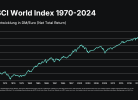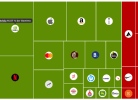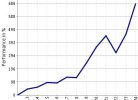By MITCH ZACKS
The stock market has been experiencing heightened volatility of late, which is normal for a host of reasons. Volatility is a regularly occurring feature of equity investing, but it is also common in the early days of a new bull market and in the months leading up to a U.S. presidential election. I encourage investors to remain patient and stay focused on the long-term.
In my view, the economy will continue recovering in the next year, and stocks will respond in kind – with plenty of bumps along the way. But I think there is another reason stocks will feel support over the next year or two, and it has nothing to do with GDP growth or politics or earnings. I think there is another underappreciated factor in play: real bond yields.
For readers who may not be familiar, a ‘real’ bond yield is the interest rate an investor gets paid on a bond, adjusted for inflation. If a 10-year bond pays 5% and inflation grows by 2% annually over that period, the real bond yield is 3%. Since inflation cuts into your purchasing power over time, it is important to think about real returns versus nominal returns in the fixed income world.
So, if real bond yields are low for intermediate and long-term U.S. Treasuries, we know investors are not being compensated very much for investing in fixed income. Today, however, real bond yields on 10-year U.S. Treasuries are not only low, they’re negative. In this environment, investors can reasonably expect to lose money over the life of the bond, when accounting for inflation. As you can see in the chart below, the 10-year Treasure Inflation-Indexed Security is firmly in negative territory, and I think it might stay there for the foreseeable future.

Source: Federal Reserve Bank of St. Louis
One of the big implications of low or negative real bond yields is the influence they have on other risk assets. If investors know that investing in 10-year U.S. Treasuries means flat or negative real returns, they are likely to look elsewhere for yield – corporate bonds, municipals, and stocks, in my view.
What’s more, the Federal Reserve has made no secret of their medium-term goals for interest rate policy. In a late August speech, Fed Chairman Jerome Powell announced a “flexible form of average inflation targeting,” which is a convoluted way of saying the Fed is now increasingly willing to allow inflation to drift above 2% for “some time.” In other words, investors can expect the Fed to keep interest rates low – and perhaps continue their accommodative asset purchases – even if inflation starts to tick higher. Real bond yields may remain low or negative for an extended period, in my view.
What does this mean for stocks and corporate bonds? On the corporate bond side, the spread between corporate bond yields and U.S. Treasuries is running below its 10-year average. This dynamic is allowing investment-grade corporations to issue an unprecedented amount of bonds to cushion balance sheets and make new investments. But it is also allowing riskier corporations to access the corporate bond market at below-market rates, which investors should be cautious about.
On the equity side, low/negative real bond yields push down the discount rate, making equities attractive relative to bonds. When pricing stocks, a quick method is to consider a corporation’s future earnings potential less the risk-free interest rate – this is the discount rate. A lower discount rate means that future corporate earnings are more valuable, which by extension tends to make stocks more attractive. If the options are to lose money on Treasuries or to own a portion of a company’s future earnings (by owning shares of stock), investors today are being nudged to choose the latter, in my view. As you can see below, the 10-year U.S. Treasury rate has sunk over the last year – boosting the case for equities, in my view.

Source: Federal Reserve Bank of St. Louis
Bottom Line for Investors
The reality of lower-for-longer interest rates is generally bad news for savers but generally good news for equity investors and borrowers. I have written before that interest rates anchored to the zero bound tend to push investors further out onto the risk curve, particularly those in search of yield. What assets are out on the risk curve ready to receive this rotating capital? Stocks and corporate bonds, in my view.
Wenn du keinen Beitrag mehr verpassen willst, dann bestell doch einfach den Newsletter! So wirst du jedes Mal informiert, wenn ein neuer Beitrag erscheint!








Hello, just wanted to say, I enjoyed this blog post.
It was practical. Keep on posting!
„what assets are ready to receive that capital?“ Meine Befürchtung für den durchschnittlichen Deutschen „Investoren“: er bleibt seinem Tagesgeld treu. Die „mutigen“ gehen in Immobilien. Kaufpreise jenseits der 40 fachen Jahresmiete. Vielleicht noch Gold…
Yep. So ist es wohl.
@Bernhard Ress
Der „durchschnittliche deutsche Investor“ bleibt beim Tagesgeld. Ok, das ist nicht besonders schlau, denn ein banaler ETF Sparplan würde weder Zeit noch Mühe kosten.
Andererseits kann man von niemanden verlangen, daß er seine Zeit mit stundenlanger Lektüre von Bilanzen, Charts und Unternehmensberichten verbringt, wenn ihn das nicht interessiert. Es ist schließlich Lebenszeit und Freizeit, nicht jeder hat soviel davon. Ich würde mich zu Tode langweilen, müßte ich mich täglich seitenlang mit Apple beschäftigen. Selbst als Pensionist mache ich das nicht. Ich spiele lieber Gitarre, auch wenn dabei keine Rendite herausschaut.
Was Christian macht, ist höchst professionell und ich vermute, er liebt es leidenschaftlich, daher schaut auch was heraus.
Aber lasst doch den „durchschnittlichen deutschen Investor“ damit in Ruhe, den langweilt das. Der hat sein Tagesgeld, sein Gold und, wie gesagt, der ETF Sparplan fehlt ihm noch, sonst aber nichts.